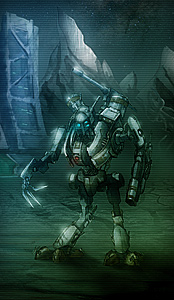Background story
The age began in the manner of all ages: with the collapse of another.
The great ravening beast of Earth's cultures had fed long and hard upon her bounties, but when she could no longer sustain humanity, mankind stretched its reach further to the solar system and soon found that even it could not sustain its hunger. Governments, ill-suited to pacifying a population which demanded more than they were able to give, collapsed. Those that rose from the ashes of economic and military warfare were shells of the entities of the previous millennia. The new rulers of humanity were instead those that could feed its ceaseless demands, those that had long grown accustomed to its insatiable hunger: corporations. It was now to corporate logos and enclaves that people paid heed, and governments were scarcely more than a token nod that was largely ignored. For the new gods of men, megacorporations, could satisfy what the governments could not - the new and final currency of mankind:
Energy.
Even the far more efficient megacorporate models, though, could easily forecast a time where the still-increasing demands of humanity would outstrip even their systems, and put the megacorporations in the same position as the governments they had helped to bring down. The solar system's resources would delay this doom for a time, but ultimately, a greater solution had to be found. Three different corporations rose to the fore of this drive for energy research. Representing a dominant economic paradigm in each of their respective areas - Truhold-Markson's strength in the former United States nation and the Americas, ICS largely holding the formerly European, African, and Soviet assets, and Asintec controlling the Chinese and other Far East territories - each applied their expertise in different areas, all aiming for the same goal: feed the superculture of consumption that they had encouraged and risen to power on, before it in turn consumed them.
Most of the hopes of mankind in the twenty-first century had largely proven false - solar, water, and nuclear power all had profound enough problems to prevent them from being the energy source that humanity needed. Large amounts of time and effort were expended on a variety of possibilities, and finally, humanity found at least one worth pursuing: they would create a cold fusion plant in a geostationary orbit, capable of beaming its energy down to the population, without risk of pollution or terrorist attack. The Perpetual Energy Renewal Project was launched on August 13th, 2192. If anyone noted the ominous nature of the date, they chose not to mention it.

Initial communication with the station indicated no particularly troubling data, but a massive explosion was detected from the ground a week after the station became active. All communications from the facility immediately ceased. Radiation emissions across the entire spectrum were now emanating from the structure. Since the telemetry from the station was now completely offline, the scientific community began analyzing all available data while the rescue effort for the station was mounted. One team of scientists made a very strange discovery: a portion of the light being emitted from the station - not a large portion, but statistically significant - was standard, run-of-the-mill starlight. What made this particularly unusual is that the light was emanating from inside the structure. Further analysis of this light revealed another highly unusual trait: the spectra of the starlight was not from the Sun.
The bizarre nature of this discovery could not be overstated. Great emphasis was immediately placed on on recovering the station's technology and telemetry. What they found is still not entirely known, but what is known is this: whatever had gone wrong with the cold fusion experiment had allowed the scientists to open very small, particle-sized wormholes into distant space. The "starlight" emissions coming from the station were due to a massive number of these individual particle-sized phenomenon. This fundamentally powerful scientific discovery gave birth to what is now considered the most powerful political and economic body in human history: the Pan-Global Corporate Syndication, now commonly known as the Syndicate. While the exploration possibilities through the wormholes were significant, none of the three most dominant megacorporations had the assets and technology to make the effort on their own. Truhold Markson, ICS, and Asintec banded together on what - at the time - was viewed as a highly speculative venture. While the particulars of the exploration technology is a very tightly held secret, the Syndicate has apparently developed the means to deliberately, in a controlled manner, open wormholes to areas of space as they see fit. The limitation of this technology (at present) is that the wormholes remain of a microscopic size - nothing larger than a nanobot can be sent through. This did, however, allow for space exploration on an unprecedented scale via nanoprobes.
It was in this manner that Nia and its residents were first discovered: humanity was no longer alone.

The Syndicate's discovery of an alien life form was, at the time, kept absolutely secret. What is now known about Nia's dominant "life form" is that they are a race of synthetic beings most similar to the human concept of "robots." Initial Syndicate reports concluded that there had to be some kind of undiscovered life on the planet controlling all the "robots" remotely, but to date no such information has ever been discovered: modern science and its definitions of life, theories about how life evolved, and what constitutes a life form have still not recovered.
Although an interesting tidbit to Syndicate's research divisions, the overall goal of finding an energy source had not been furthered. The conditions on Nia, though, showed a great deal more promise. Nia was a highly unusual planet, particularly for one that supported life: it orbits around the common center of a dual-star system, ensuring highly intense sunlight during daytime hours. Because of the tremendous gravitational pull involved, and Nia's particularly dense core, the planet generates surprisingly large amounts of static electricity in its oceans, making them highly dangerous to anything which uses electricity in any form: robots or more traditional human life. More interesting to Syndicate science, though, was what Nia represented: an infinite, planet-wide source of solar power, a highly potent, self-generating electrical current at sea to be tapped, and plants which were tremendously active converters and carriers of solar energy, thanks to the biodevelopment of life on a planet sunlight was twice as potent as anywhere on Earth. Nia was an infinite energy paradise - but only if they could harness it. Attention returned again to the life forms of Nia.

The synthetic life of Nia represented a considerable puzzle to Syndicate science. Despite having no air or naval assets, a considerable amount of military might was possessed by the Nians - and this was put on display because the Nian "peoples" were clearly at war with each other. Although historical causes for the war are largely unknown, we have since been able to loosely understand the beginnings of the conflict.
There are three factions in conflict on Nia: the Pelistal, the Nuimqol, and the Thelodica. We now know that the Pelistal faction represents a major empire that has since fallen into decay. The Nuimqol are the reactionary element that sprang from that decay, and seem to largely be disaffected industrialists and soldiers. The Thelodicans are something of a strange third faction - they are not directly tied to either group, but seem to operate as traders, opportunists, and a balance between the other two factions, shifting back and forth as one side or the other appears to be gaining a potentially dangerous advantage. While the Pelistal empire, thanks to its age, represents the largest military entity on the planet, the Nuimqol forces are well-designed and well-experienced to battle their foe. It is only the balancing presence of the Thelodica that keeps either side from wiping out the other.
The Syndicate, being adept in politics and intrigue in warfare, understood all of what their scouting reports told them clearly. What they were unprepared for, however, was the highly advanced nature of Nian ground combat. While the basic tactical system was not altogether different than humans, the sophistication of Nian technology was considerably greater than that of humanity. Major resources would be required before humanity could attempt a ground invasion of Nia - something that might be practically impossible anyhow, since there had been no success at opening a larger variety of wormhole. The Syndicate was placed in a frustrating position - here was indeed a great, if not perpetual, solution to their energy needs, but it was just out of reach.
Enter William Berger.
An ICS scientist, Berger presented to the Syndicate a possible solution to their fruit hanging just out of reach. The Nians, Berger reasoned, might operate on the same principles of communication as human synthetics - electronic commands and programming. If this was the case, a well-tailored virus could, in theory, allow Syndicate scientists access to the network of the Nians - possibly allowing them to scout out further information about what was going on between the various factions of Nia, and, in a best case, allowing for communication with one of the factions, giving humans a foot in the door.
Lacking any better suggestions from the Syndicate military divisions and feeling increasing amounts of pressure to deliver energy supplies, Syndicate executives ordered the release of the Berger Virus through the wormhole on December 7, 2192. The probes were sent through, and the Syndicate waited. The results have forever changed the fate of human and Nian alike.
The closest analogy Syndicate scientists have been able to provide to explain the results of the Berger virus harkened back to the conquering of the Americas nearly a millennia earlier - the native peoples of the continent had simply never encountered many of the diseases the explorers brought with them, and so were defenseless against their power. So it was for the Nians and the Berger Virus. Originally a desperate attempt to take over a small portion of the Nian network for information gathering, the Berger Virus delivered far more: control of a small army of the Nian peoples, their manufacturing, and their armories. It was not until the virus had succeeded in conquering six entire islands of networks that the Nians were able to put up sufficient firewalls to halt the further attack of the virus. Although Syndicate military personnel were in no position to adequately utilize the gains they had suddenly been handed by the Berger Virus, the Nians - divided as they were and shocked by this sudden new foe - were in no position to retake their lost territory.
And so it was that the battle for Nia began.

It is well-known since then that the Syndicate has been hiring the greatest minds from all over Earth to bring the battle to Nia to a conclusion. Through their remotely controlled systems, the Syndicate has been able to manufacture more Earth-aligned robots, weapons and equipment, and gradually have expanded their control to an area including twelve islands. Within these islands, a safe zone has been created, and Project Perpetuum was born. The object of Project Perpetuum is simple: deliver energy to Earth. While the Syndicate's military arm continues to battle for greater control of more territory, Project Perpetuum's job is to gather as much energy as possible. The project, in the minds of Syndicate brass, will only be legitimate when it has begun to deliver returns.
As one of the Agents of Project Perpetuum, you are given basic tools and advice as to how to proceed: acquire materials to manufacture weapons of war, build industry capable of sustaining your needs, maintain control of Syndicate-captured land, and most of all: acquire energy for Syndicate transmission to Earth.
On Nia, the potential for riches and glory are vast. Are you ready to seize both, Agent?




